|
| |
Back to homebuilts
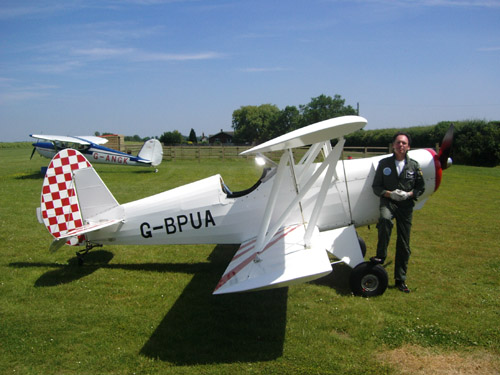 |
The EAA biplane was developed in America for
construction by members of the Experimental Aircraft Association,
the American equivalent of Britain's Popular Flying Association and
the US regulator of homebuilt aircraft construction. The design was
overseen by long serving EAA president Paul Poberezny. It is a
sporty little biplane, primarily of wood and fabric construction
with a welded steel tube fuselage. Wing span is 20 feet, length 17
feet and maximum weight 1,150lb. Top speed is 105mph.
This one, fitted with a Lycoming O-235 engine,
was pictured with owner Mark Gorlov at Top Farm in July 2005. |
|
|
The Europa is a particularly successful light
fibreglass aircraft, designed in England by Ivan Shaw, available as
a kit to home builders. The original Europa had a single main wheel
plus stabilising outriggers on the wings (rather like the B-52 or
the U-2.) Although popular, the handling of this version was a bit
tricky for some pilots; so an alternative with a `standard' tricycle
undercarriage was developed. A tailwheel version is, rather
surprisingly, less popular. Also, the original design was rather a
tight fit for tall pilots, so the Europa XS was developed, which has
an extended cabin height. The normal version is 19 feet 2 inches
long with a wing span of 27 feet 2 inches (there is an extended span
variant too). It can be powered by a variety of engines, most
popularly the Rotax 912, which gives is a 160mph cruising speed and
range of 840 miles. It is a two seater, with gross weight of
1,370lb. There are about 215 on the British civil register as at
June 2006. More details can be found on
www.europa-aircraft.co.uk. Top:
Monowheel, Cranfield, July 1988. Middle: Tri-gear, Kemble, July
2005. Bottom: Tailwheel, Shobdon, June 2006. |
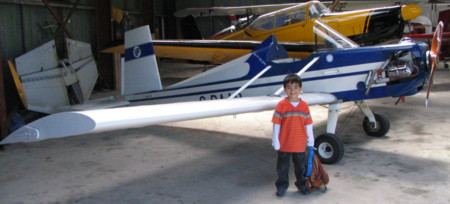 |
The Evans VP1 is sometimes known as the `Volksplane'
because of its intended ability to bring flying within the reach of
anybody, like the original Volkswagen (Peoples' Car). It is probably
the cheapest way anybody can get themselves into the air under
power. It was designed in America by Californian W.S. Evans. Wing
span is 24 feet, length 18 feet and maximum weight 750lb. Although
its construction is extremely simple, its narrow fuselage also gives
very little drag, so it manages a respectable 120mph top speed on
its 1,834 cc converted Volkswagen engine.
This one, built in 1973, was at Breighton in
June 2007. |
 |
The Evans VP2 is essentially a two seat
version of the VP1. Performance is not sparkling, but it potters
along very nicely for a pilot on a low budget.
This one, fitted with an enclosed cabin and a most unusual
propeller, was at
Cranfield, July 1984 |
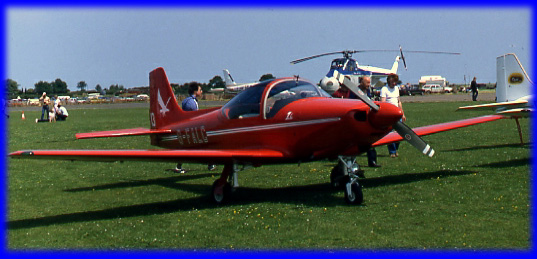 |
The Falco F8L is a Ferrari of homebuilts. It
was designed in the 1950s by the superbly talented Italian designer Ing Stelio Frati. A sleek stylish two seater, of primarily wooden
construction and powered by a 150 or 160hp engine, with retractable
undercarriage, its top speed is a serious 200mph, while its 850 mile
range makes it a very practical touring aeroplane. Wing span is 26
feet 3 inches and length 21 feet 4 inches, maximum weight 1,800lb.
Many were factory built by Aeromere, later Laverda, in Italy,
and some by another Italian concern, Aviamilano. Plans are also
available for home construction. It is a popular choice for
ambitious builders brave enough to master its complexity; their
reward is an incomparable and beautiful machine.
This one, factory built by Aeromere, was at
Cranfield in July 1983. |
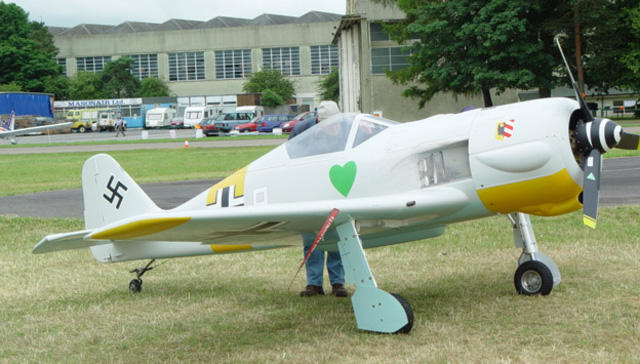 |
This Focke-Wulf 190 replica is a homebuilt
kit supplied by American kit maker WAR replicas (www.warreplica.homestead.com).
At 16 feet 7 inches long and 20' wing span, it is just under 60%
scale. It is made from a basic wooden frame, with the shape made of
foam and skinned with fibreglass. Power is from a radially cowled
Continental O-200 engine (rather like the annular cowling over a
Junkers Jumo inline in the long-nosed FW190D). Like the original it
is a single seater; unlike the original, its top speed is 165mph and
gross weight 920lb. There are about five in the UK.
This one was pictured at Kemble, July 2005 |
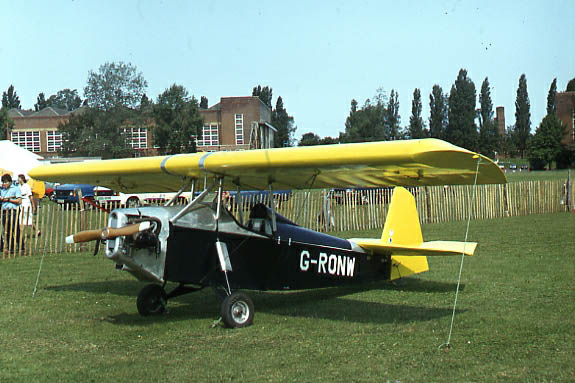 |
Meet FRED! The acronym stands for `Flying
Runabout, Experimental Design'. It is a simple, wood and fabric
parasol wing monoplane designed by Eric Clutton and first flown in
1965. It is notable for its short, deep wing, of only 22 feet 6
inches, bearing a passing resemblance to the Luton Minor (see
below). Length is 17 feet. A single seater, its maximum weight is
770lb. It cruises at a sedate 65mph.
For many years Mr Clutton's was the only FRED
to have flown, but in the 1980s many more plans were sold and the
simplicity of the design made it more popular. There are currently
26 registered in the UK. This one, fitted with a 1.8 litre
Volkswagen engine, was pictured at Cranfield in July 1983. |
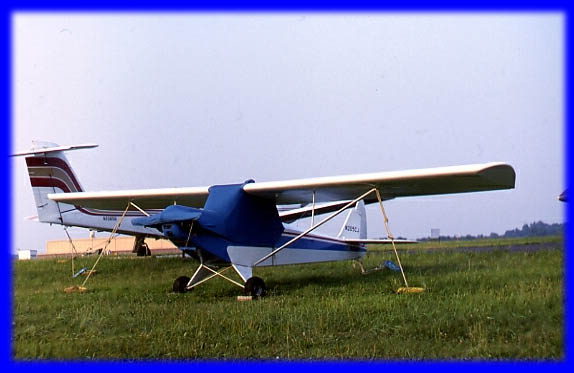 |
I know very little of the Geissinger CJ2V
other than its being a one-off parasol-wing homebuilt, designed by
Walter H. Geissinger, and powered by a 36hp converted Volkswagen
engine. I am not aware of more than one having been made.
Picture taken at
West Chester, August 1987. |
 |
The Glasair RG was one of the earliest of the
fibreglass homebuilts, dating from 1980, and indeed claims to be the
world's forst pre-moulded composite kit aircraft. It is one of the
relatively few homebuilt types to feature a retractable
undercarriage. It is quite heavy (2,100lb) for a modestly sized (20
foot 6 inch length, 22 foot 3 inch span) two seater. Much of the
weight is probably due to the 180hp Lycoming O-320 engine, plus the
extra weight for structural strength - it is designed to be
aerobatic. Performance is excellent: it claims a top speed of 210mph
and range of 1,000 miles. More information is on
www.glasairaviation.com.
Cranfield, date unknown |
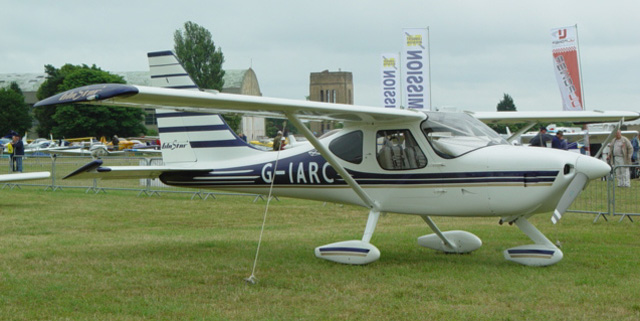 |
The Glastar is a popular, simple two seater
of mixed aluminium and composite construction, marketed by the
makers of the Glasair range. Various engine choices are offered,
most popular being the Lycoming O-320 again. It is 22 feet 9 inches
long with a 35 foot wing span and gross weight is 2,000lb. It
cruises at 160mph for a range of 500 miles.
This one was at Kemble,
July 2005 |
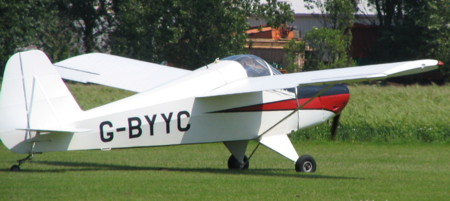 |
The HAPI Cygnet was an American design,
marketed by Viking Aircraft of Wisconsin. It is a kit, made of wood
and metal, powered either by a VW or Rotax engine. It is a little
two seater, gross weight 1,100lb, and having a top speed of 135mph.
This one visited
Cranfield, date uncertain |
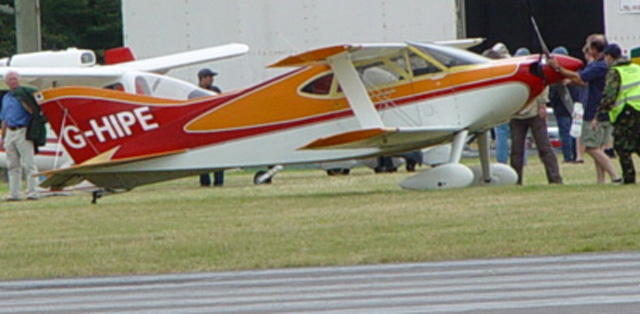 |
The Hiperbipe is a two seat aerobatic biplane
designed by American Mr Hobie Sorrell. Basically a wood, plywood and
fabric machine, it first flew in March 1973. Normally powered by a
180hp Lycoming IO-360 engine, it can cruise at 150mph for a range of
500 miles. It is 20 feet 10 inches long, with a wing span of 22 feet
10 inches. This smart example was at Kemble,
July 2005 |





|